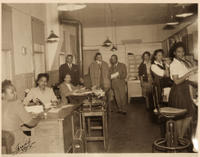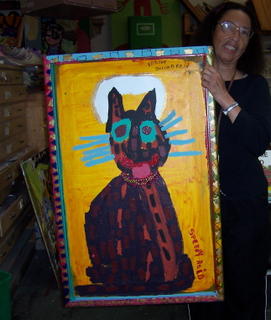

Life has closed in tightly but nicely, leaving little room for telling the stories ...
The work goes well, and I'm having that wonderfully rare feeling of fulfilling a role that no one else can; a role that is truly essential to the work underway. I can't recall when this has happened before in my life ... but I'm sure it has because there's a familiar feeling about it. Being in these advanced years gives permission to speak of it unselfconsciously, without false pride but with real appreciation for the enormous privilege I've been granted to continue being of service in the creation of a national park.
I'm building a data base for the planning of the community outreach component of the park. "Rosie" has been several years in the making -- and its come a long way. There are visitors arriving almost everyday from Everywhere, USA, to take the driving tours of the park-in-progress.
The archives are steadily growing and already scholars of the period of WWII are stopping in and requesting time and space to explore the collection of papers, artifacts, oral histories, etc. There's the steady click of computers in our temporary reception center at city hall -- as young interns continue the never-ending task of data entry and followup telephone calls to Rosies throughout the country who've made contributions that require clarifying information.
But there's an important area that will begin to come alive now. It's the place where my recent work experiences come into play. The city of Richmond and the surrounding constituency area of Greater Richmond (at least 4 small cities) need to begin to buy into their roles as host communities. It won't be easy. What has been designated by Congress as an urban national park made up of those structures that best tell the story of the World War homefront war effort, has been regarded for 60 years as blight awaiting demolition and redevelopment by those who've lived and worked in their shadows. It will take many visitors over the next few years -- folks who'll arrive with reverence and enthusiasm and a sense of honor that those of us who've lived that history must "catch." There will at some time be a tipping point where their reverence will become true for us, too. I'm sure of it. And for one who spent the war working in a Jim Crow segregated union hall, that's quite a statement.
History was not necessarily kind to many who were caught in the chaotic period of economic adjustment in the years following the declaration of peace. The temporary war housing was torn down only weeks after the war ended, casting many into homelessness. Jobs disappeared for most, unceremoniously without the necessary time to find work elsewhere. Displacement was a fact of life, and the option to return to the places from which they'd come was an unreal choice. Few were willing to return to the share-cropping fields of the south, or, to the kinds of poverty they'd known in places of even less opportunity. Women, especially, were no longer willing to settle for homemaking, exclusively, and the future for them was in the place where they'd learned new skills and earned their independence. The ground had shifted under us all.
Creating ways to explore that history in these host communities -- but doing so informed by the struggles that followed in national life will be one of the exciting results of having the park created on our shores. This may describe the most interesting work of community outreach; or it can.
Despite the great work of Henry J Kaiser in creating the most powerful defense industry in history (5 shipyards here, alone); the first 24 hour-a-day childcare program in the nation; the first HMOs; and giving birth to mass production on a scale unprecedented. He was on a mission to defend the country against the Axis powers. He was in no way conducting a social experiment. He created a huge "war machine" composed of thousands of willing but unknowing hands of every size, shape, and color -- hands attached to over-aged men, under-aged boys, and eager women from everywhere. He was running an around-the-clock battle to build and supply 747 ships (before war's end) -- some completed and launched in a period of no more than five days.
The human drama being played out in these communities over the next 20 years laid the groundwork for much that followed in the ensuing years. It would erupt into the Civil Rights Movement in the Sixties, and life would never be the same for any of us.
I, for one, went from the position of a lowly young clerk in that Jim Crow union hall on Barrett Avenue in those years -- to being named a "Woman of the Year" before the California State Legislature in the year 1995. That required tumultous political and social change in a part of the country that has never ceased to create many patterns of change for the rest of the country and the world to emulate.
The greatest of the untold stories may have occurred not during "The Good War," but in the years that followed -- as the direct result of our homefront experience in this rapidly-changing world.
That is surely enough upon which to begin to build the community outreach component of the Rosie The Riveter Homefront Historical National Park. Finding ways to re-open those much-needed conversations will be challenging but probably more rewarding than almost anything I can think of these days.
Nostalgia is beginning to crowd out the residual anger that's taken up space in my psyche for so long; space that I need now for other things. Perhaps that will happen for others as well.
I'd never have dreamed ... .
See what I mean?
Right photo: 1995 was a big year. Was honored by being named "Woman of the Year" for the 14th Assembly District by Assemblymember Tom Bates in ceremonies at the capitol in Sacramento.
Left photo: Office of Boilermakers A-36 (that "A" stands for auxiliary) the Jim Crow union out of which all black shipyard workers were assigned. It stood at 1600 Barrett Avenue, Richmond, California. Circa 1943.
